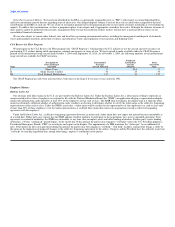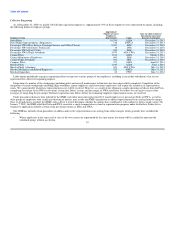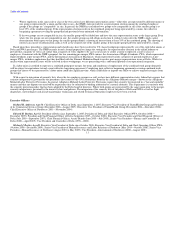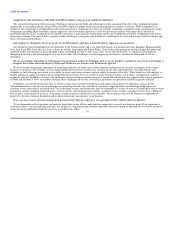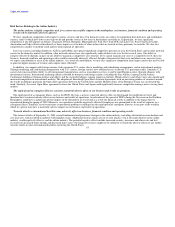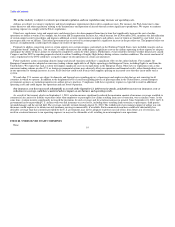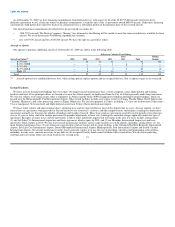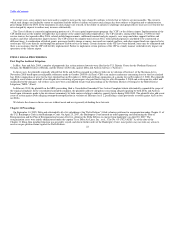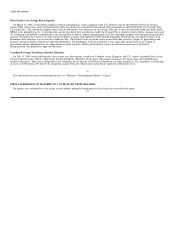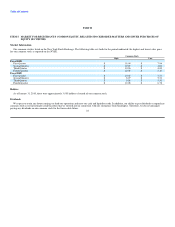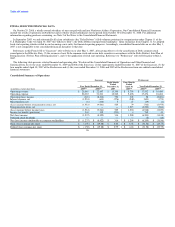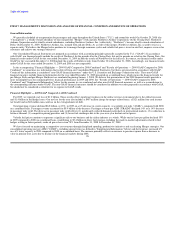Delta Airlines 2009 Annual Report Download - page 23
Download and view the complete annual report
Please find page 23 of the 2009 Delta Airlines annual report below. You can navigate through the pages in the report by either clicking on the pages listed below, or by using the keyword search tool below to find specific information within the annual report.
Table of Contents
Risk Factors Relating to the Airline Industry
The airline industry is highly competitive and, if we cannot successfully compete in the marketplace, our business, financial condition and operating
results will be materially adversely affected.
We face significant competition with respect to routes, services and fares. Our domestic routes are subject to competition from both new and established
carriers, some of which have lower costs than we do and provide service at low fares to destinations served by us. In particular, we face significant
competition at our hub airports in Atlanta, Cincinnati, Detroit, Memphis, Minneapolis/St. Paul, New York-JFK, Salt Lake City, Paris-Charles de Gaulle,
Amsterdam and Tokyo-Narita either directly at those airports or at the hubs of other airlines that are located in close proximity to our hubs. We also face
competition in smaller to medium-sized markets from regional jet operators.
Low-cost carriers, including Southwest, AirTran and JetBlue, have placed significant competitive pressure on us in the United States and on other network
carriers in the domestic market. In addition, other network carriers have also significantly reduced their costs over the last several years. Our ability to
compete effectively depends, in part, on our ability to maintain a competitive cost structure. If we cannot maintain our costs at a competitive level, then our
business, financial condition and operating results could be materially adversely affected. In light of increased jet fuel costs and other issues in recent years,
we expect consolidation to occur in the airline industry. As a result of consolidation, we may face significant competition from larger carriers that may be able
to generate higher amounts of revenue and compete more efficiently.
In addition, we compete with foreign carriers, both on interior U.S. routes, due to marketing and codesharing arrangements, and in international markets.
Through marketing and codesharing arrangements with U.S. carriers, foreign carriers have obtained access to interior U.S. passenger traffic. Similarly, U.S.
carriers have increased their ability to sell international transportation, such as transatlantic services to and beyond European cities, through alliances with
international carriers. International marketing alliances formed by domestic and foreign carriers, including the Star Alliance (among United Airlines,
Continental, Lufthansa German Airlines and others) and the oneworld Alliance (among American Airlines, British Airways and others) have also significantly
increased competition in international markets. The adoption of liberalized Open Skies Aviation Agreements with an increasing number of countries around
the world, including in particular the Open Skies agreement between the United States and the Member States of the European Union, has accelerated this
trend. Similarly, the recent Open Skies agreement between the United States and Japan could significantly increase competition among carriers serving those
markets.
The rapid spread of contagious illnesses can have a material adverse effect on our business and results of operations.
The rapid spread of a contagious illness, such as the H1N1 flu virus, can have a material adverse effect on the demand for worldwide air travel and
therefore have a material adverse effect on our business and results of operations. Acceleration of the spread of H1N1 during the flu season in the Northern
Hemisphere could have a significant adverse impact on the demand for air travel and as a result our financial results in addition to the impact that we
experienced during the spring of 2009. Moreover, our operations could be negatively affected if employees are quarantined as the result of exposure to a
contagious illness. Similarly, travel restrictions or operational problems resulting from the rapid spread of contagious illnesses in any part of the world in
which we operate may have a materially adverse impact on our business and results of operations.
Terrorist attacks or international hostilities may adversely affect our business, financial condition and operating results.
The terrorist attacks of September 11, 2001 caused fundamental and permanent changes in the airline industry, including substantial revenue declines and
cost increases, which resulted in industry-wide liquidity issues. Additional terrorist attacks or fear of such attacks, even if not made directly on the airline
industry, could negatively affect us and the airline industry. The potential negative effects include increased security, insurance and other costs and lost
revenue from increased ticket refunds and decreased ticket sales. Our financial resources might not be sufficient to absorb the adverse effects of any further
terrorist attacks or other international hostilities involving the United States. 18



